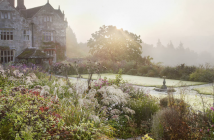With the news that after 157 years of near unbroken chiming Big Ben is to be silenced for essential repairs, Margaret May pays her respects to this London institution, and the iconic gothic tower in which he sits…
Can there be a more iconic symbol of London than the elegant and beautiful clock tower that adjoins the Houses of Parliament and stands, proud and serene, above some of the most memorable sights of London?
Rising from the northern end of Westminster Bridge, the Elizabeth Tower looks out across Parliament Square, past the statue of our statesman Winston Churchill, and over to Westminster Abbey; down Great George Street and on into Birdcage Walk, with a tantalising glimpse of the greenery of St. James’ Park; over to Whitehall and its government buildings; down along the Embankment stretching eastwards towards the City of London; over the rippling waters of the River Thames to the South Bank, the London Eye, Lambeth Palace; and then across the great Palace of Westminster itself.
It can be no surprise really that so many of the prints and postcards generated for visitors and tourists to London often feature this tower, from so many different angles – and usually with one of our ubiquitous red double-decker buses, or black cabs, in the foreground. Welcome to London!

Well, I must admit here that, despite a reasonable knowledge of London and its history, I had no idea that the tower was called the Elizabeth Tower. For me, as with so many others I imagine, it has always been Big Ben. It has always been the first and last thing I see as my train arrives or departs from Waterloo Station; a constant as I emerged from Westminster Underground station en route to work. I know, also, that it is a welcome sight for those marathon runners as they complete that gruelling stage of the race from the Tower of London to the end of Embankment and make that, almost, final turn down towards Buckingham Palace and into The Mall. It’s just Big Ben to everyone.
The Elizabeth Tower was, apparently, previously known as the Clock Tower but the name was changed in 2012 to mark the occasion of Queen Elizabeth’s Diamond Jubilee – incidentally, for the pedants out there, it was only ever called St Stephen’s Tower by the Victorians. The tower was built to a design by Augustus Pugin in 1859 and is of his famed, and beautiful, Gothic Revival style. At a height of 315 feet its brickwork structure is topped by a framed cast-iron spire. This was to be Pugin’s last architectural design before he sank into a darker world of madness and death.
Thus the tower is Elizabeth. Ans Big Ben, as we all know, is the name of the very great bell which is housed within. The original bell, cast in 1856, weighed 16 tons but cracked beyond repair while being tested. Its replacement, in 1858, weighed 13 tons, is 7 feet high and was hauled up to the belfry over a course of 18 hours. It is debatable as to whether the name honours the name of Sir Benjamin Hall, chief commissioner of works at the time – and his name is inscribed upon the bell – or a contemporary heavyweight boxer named Benjamin Caunt.

What a delight to discover that it is possible to take a tour of the Tower and not only admire the views from the top, but also see the mechanisms of its four-faced clock. It is not quite as simple as it sounds, however – the tours are only available to UK residents and must be sponsored by a Member of Parliament or a member of the House of Lords. There is generally a waiting list of some six months since MPs may make only limited applications for their constituents to the climb the tower each month.
And ‘climb’ is the operative word here as, there being no lift, a total of 334 spiral limestone steps must be overcome before reaching the top and gazing out, 62 metres up, across the spectacular sights of London. Health and Safety instructions must be read first and disclaimers signed. Stringent security measures are in place (airport-style) and this may take some 15 minutes to clear. It’s no good having a sudden fear of heights half-way up as one may not leave the tour unless there is an available member of staff to escort you back down – this, obviously again, for security reasons. For all this rigour, however, the tours are free of charge and are led by trained guides. Tour times are set to coincide with reaching the top and hearing the bell strike the hour. Reaching the top at last, and regaining one’s breath, it is possible to go behind the dials of the clock – both designed by Pugin – and also to see the mechanism room, a fascinating feature showing the workings of the pendulum.
 Over the years various factors have affected the clock’s mechanics I find: bombing raids during the Blitz did some damage to the dials but did not stop timing accuracy or chiming (in fact, the only occasion the clock stopped chiming during the war was for 12 hours after a workman dropped a hammer into the machinery in 1941); on another occasion, in 1949, a flock of starlings perching on the minute hand was enough to slow the time by four and a half minutes; and the clock face lights were not used for two years during WWI to avoid attracting the German Zeppelins. The bells have been silenced to mark great occasions, namely for the funerals of Prime Ministers Winston Churchill and, later, Margaret Thatcher. The bells, the tower, and the clock, then, have clearly had more than simply an emblematic element in British history.
Over the years various factors have affected the clock’s mechanics I find: bombing raids during the Blitz did some damage to the dials but did not stop timing accuracy or chiming (in fact, the only occasion the clock stopped chiming during the war was for 12 hours after a workman dropped a hammer into the machinery in 1941); on another occasion, in 1949, a flock of starlings perching on the minute hand was enough to slow the time by four and a half minutes; and the clock face lights were not used for two years during WWI to avoid attracting the German Zeppelins. The bells have been silenced to mark great occasions, namely for the funerals of Prime Ministers Winston Churchill and, later, Margaret Thatcher. The bells, the tower, and the clock, then, have clearly had more than simply an emblematic element in British history.
The Elizabeth Tower and Big Ben have stood for 156 years in an imposing position at the very centre of historic Westminster. It is something to be greatly admired, not only for it’s architectural splendour but also, I feel, for the almost subconscious sense of authority its chimes inspire. They herald our news on television and radio, they signal the start of a two minute silence on Remembrance Day – always well observed in Whitehall and its surrounding streets and, finally, they strike at midnight on New Years’ Eve and somehow, watched and listened to by millions up and down the country, unleash the revelry and celebrations for the end of the old and the start of the new.
For more information about Big Ben and the Elizabeth Tower, including details of tours and the repairs schedule, visit www.parliament.uk.




